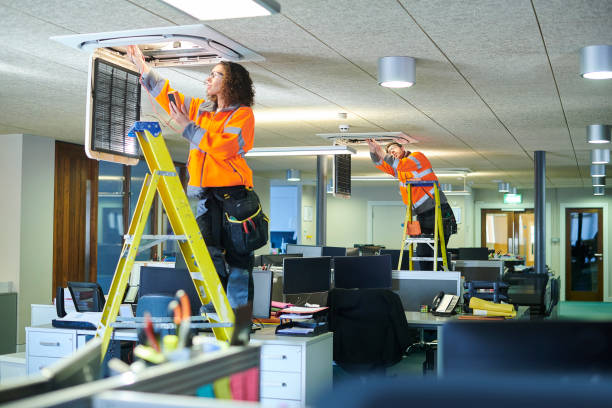Upgrading Your Office HVAC? Here’s What You Need to Know
Creating a productive work environment requires effective office HVAC systems that maintain comfortable temperatures and ensure optimal air quality. Commercial HVAC systems cater to the distinct needs of office buildings, delivering efficient heating, ventilation, and air conditioning throughout expansive spaces. Whether managing a small office or overseeing commercial buildings with multiple floors, understanding HVAC systems is essential for maximizing efficiency and controlling energy costs.
This guide covers various types of systems, energy efficiency strategies, and selecting the right HVAC system for your business, while ensuring proper ventilation.
Understanding Office HVAC Systems
Office HVAC technology regulates indoor heat, maintains fresh air circulation, and controls temperature throughout workspaces. HVAC stands for Heating, Ventilation, and Air Conditioning—three key components working together to create comfortable conditions. Unlike residential systems, commercial HVAC systems are engineered to handle large spaces, different zones, and varying occupancy levels throughout the workday.
The building’s HVAC system serves as the backbone of indoor climate control, affecting everything from employee productivity to operational expenses. Commercial HVAC systems account for approximately 40% of a building’s total energy consumption, making them the largest energy consumer in most office buildings.
How Commercial HVAC Systems Work
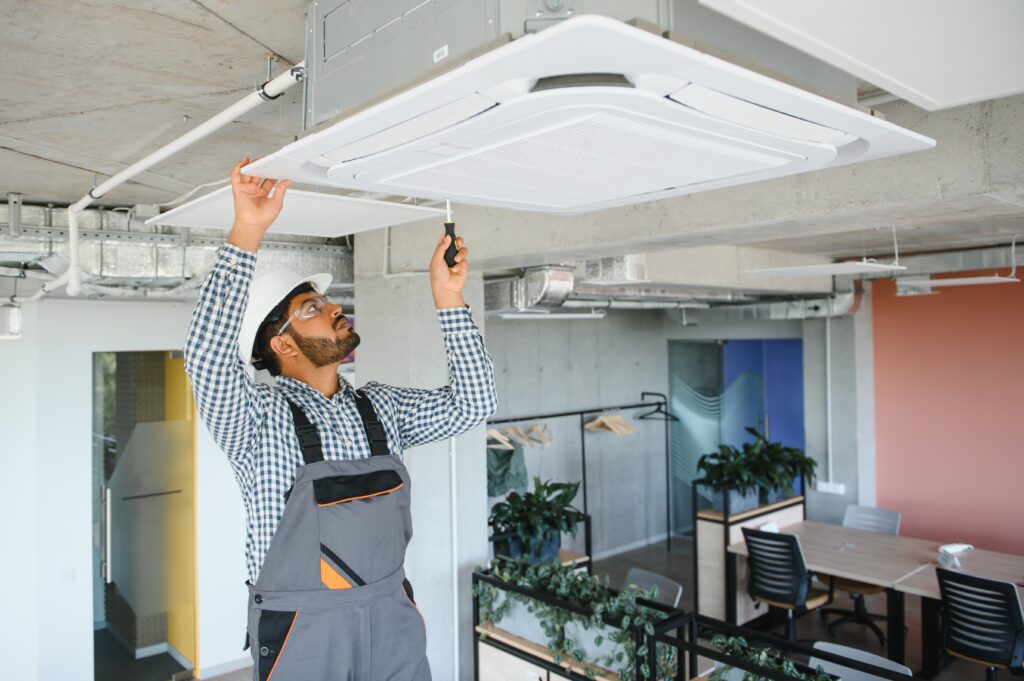
Commercial HVAC systems work by continuously cycling air through the building, filtering contaminants, adjusting temperature, and controlling humidity levels. The process begins with HVAC units drawing fresh air from outside or recirculating indoor air through the system. This air passes through HVAC filters that remove dust, allergens, and other particles before being heated or cooled to the desired temperature.
Once conditioned, the air is distributed through ductwork to different areas of the office building. Advanced systems create different zones, allowing customized temperature control in specific areas based on usage patterns and specific needs. This zoning capability proves particularly valuable in office buildings where conference rooms require more ventilation during meetings, while storage areas need minimal climate control. However, in typical buildings, 20-30% of air moving through duct systems is lost due to leaks and poor connections, resulting in higher energy bills.
Different Types of Office HVAC Systems
Selecting the right system requires understanding the different types available and how they align with your building size, floor space, and energy efficiency goals.
| System Type | Best Application | Installation Complexity | Energy Efficiency | Maintenance Access |
| Split Systems | Small to medium offices (under 5,000 sq ft) | Easy installation | Good | Moderate |
| Packaged Rooftop Units | Medium to large buildings | Moderate | Good | Excellent |
| VRF Systems | Large buildings, multiple zones | Complex | Excellent | Moderate |
| Heat Pumps | Moderate climates | Moderate | Excellent | Moderate |
Split Systems
Split systems separate the heating and cooling components, with the condenser unit located outside and the evaporator unit inside the building. These commercial HVAC systems offer reliable temperature control for offices up to several thousand square feet. The flexibility makes them ideal for businesses needing targeted climate control in specific areas without the complexity of larger commercial systems. They’re also energy efficient when properly maintained and can be scaled by adding multiple units as your business grows. Learn more about split system HVAC configurations for your office.
Packaged Rooftop Units
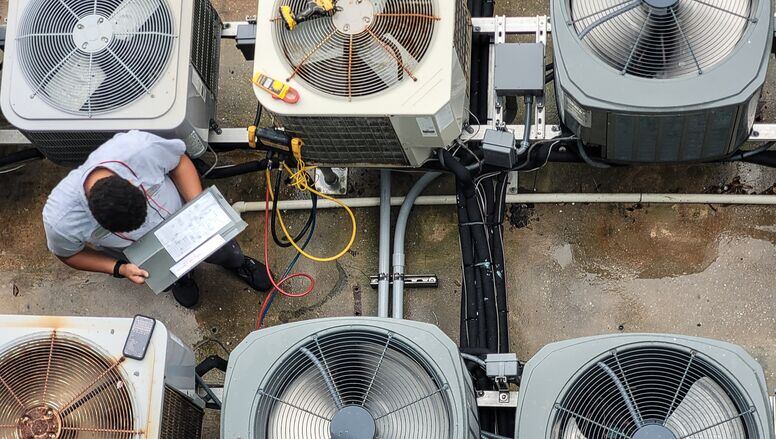
Packaged rooftop units are a popular choice for office buildings where floor space is at a premium. These self-contained HVAC equipment packages house all key components—compressor, condenser, and evaporator—in a single unit installed on the roof. This configuration saves valuable interior space while providing powerful heating and cooling for large buildings.
Why rooftop units excel in commercial buildings:
- All components are accessible from one location for straightforward maintenance
- Keep HVAC equipment out of valuable office space
- Handle substantial cooling and heating demands efficiently
- Reduce noise in occupied areas
Professional commercial HVAC installation ensures rooftop units are properly sized and configured for optimal performance.
Variable Refrigerant Flow (VRF) Systems
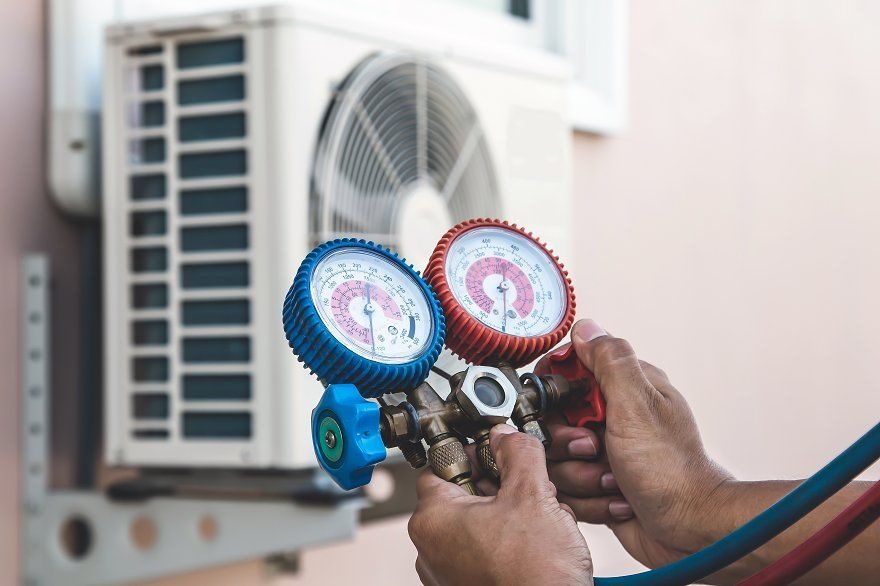
VRF systems represent cutting-edge office HVAC technology, offering exceptional energy efficiency and precise temperature control across different zones. These systems use refrigerant as the cooling and heating medium, allowing simultaneous heating and cooling in different areas of the building—a feature particularly valuable in large offices with varying thermal loads. The variable refrigerant flow design adjusts refrigerant flow based on real-time demand, maximizing efficiency by delivering only the necessary amount of heating or cooling to each zone.
This intelligent operation results in lower energy costs compared to traditional systems. VRF systems also require less floor space for equipment and offer quiet operation, making them ideal for professional office environments. To understand more about this advanced technology, explore what VRF is in HVAC.
Heat Pumps and Supplemental Heating
Heat pumps provide energy-efficient solutions for offices in moderate climates by transferring heat rather than generating it. They move indoor heat outside during summer and reverse the process in winter, making them more efficient than traditional heating methods in many applications. Baseboard heaters complement primary systems by offering supplemental heating for specific areas requiring extra warmth, such as perimeter offices or rooms with large windows.
Key Components of Commercial HVAC Systems
Understanding the key components of your building’s HVAC system helps maintain optimal performance and identify when professional service is needed. Every commercial system includes several vital elements working together to create comfortable temperatures and maintain air quality.
| Component | Function | Typical Lifespan | Maintenance Frequency |
| Air Filters | Remove particles, allergens | 1-3 months | Monthly inspection |
| Thermostats | Control temperature settings | 5-10 years | Annual calibration |
| Ductwork | Distribute conditioned air | 20-25 years | Annual inspection |
| Compressors | Circulate refrigerant | 8-10 years | Semi-annual check |
| Coils | Heat exchange | 15-20 years | Semi-annual cleaning |
| Heat Exchangers | Transfer thermal energy | 15-25 years | Annual inspection |
Air Handling and Temperature Control
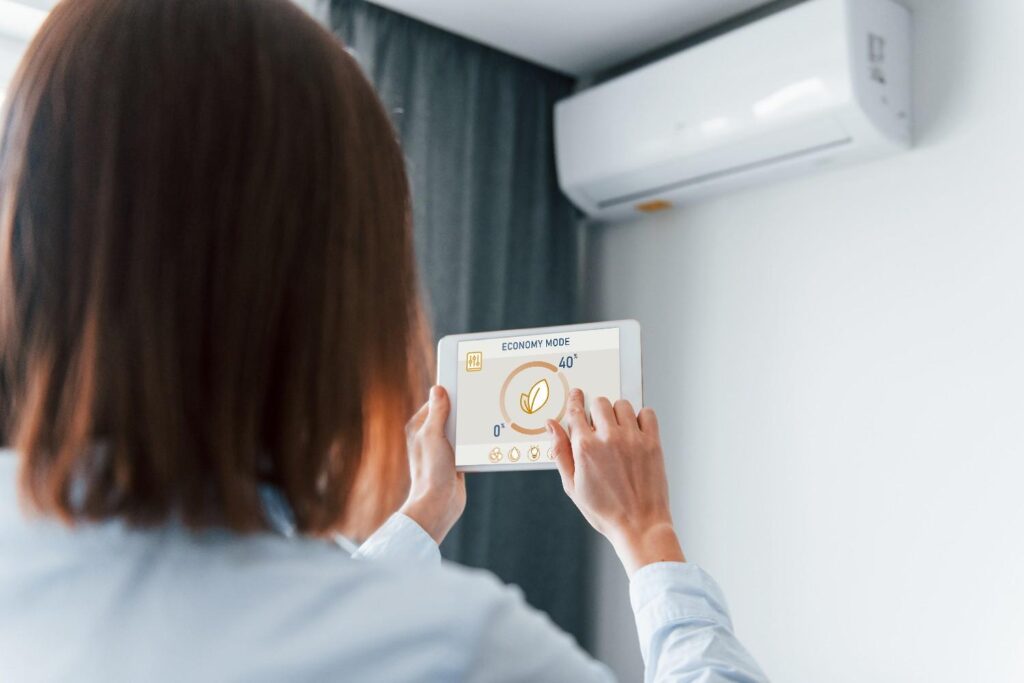
The air handling system moves conditioned air throughout office buildings through supply fans, return air systems, and dampers, controlling airflow to different zones. Proper ventilation depends on these components working efficiently to ensure fresh air reaches all occupied spaces. Modern systems incorporate air quality monitors to track conditions in real-time, automatically adjusting ventilation rates to maintain healthy indoor environments.
Thermostats serve as the command center for your office HVAC system. Advanced commercial thermostats offer programmable schedules, zone control, and remote access—features that help maximize efficiency by reducing energy consumption during off-hours. Smart thermostats learn usage patterns and automatically adjust temperature settings based on occupancy and external weather conditions, significantly reducing energy bills while ensuring comfortable conditions when employees are present.
Humidity and Air Quality Systems
Maintaining appropriate humidity levels is crucial for both comfort and equipment protection. Humidification systems add moisture to dry winter air, while dehumidification removes excess moisture during humid conditions. Proper humidity control prevents issues like static electricity, dry skin, and damage to sensitive office equipment while creating a more comfortable workspace for employees.
Energy Efficiency in Office HVAC Systems
Energy efficiency remains a primary concern for businesses managing commercial HVAC systems. Heating and cooling typically represent the largest controllable operating expense for most offices. According to the U.S. Department of Energy, heating and cooling buildings account for approximately 35% of all energy consumption. The good news? Upgrading to energy-efficient HVAC systems can reduce energy consumption by 20% to 50%.
Factors Affecting HVAC Efficiency
Several interconnected factors influence how efficiently your office HVAC system operates. Building size and construction quality play significant roles—well-insulated buildings with energy-efficient windows retain conditioned air better, reducing the workload on HVAC equipment. The square footage of your office space directly impacts system sizing requirements, and an improperly sized system wastes energy regardless of its efficiency rating.
Regular maintenance stands as perhaps the most critical factor in maintaining energy-efficient operation. Dirty filters restrict airflow, forcing systems to work harder and consume more energy. Worn components reduce efficiency over time, and refrigerant leaks in cooling systems cause dramatic increases in energy costs. Improper installation can reduce system efficiency by up to 30%, costing you more on utility bills and potentially shortening the equipment’s life.
Strategies to Maximize Efficiency
Maintenance and Upkeep:
- Implement a comprehensive maintenance schedule with quarterly inspections
- Change filters every 1-3 months for commercial systems
- Clean coils and ductwork annually to maintain optimal airflow
- Monitor refrigerant levels and repair leaks promptly
- Seal duct leaks using mastic sealant or metal tape
Technology and Equipment Upgrades:
- Install high-efficiency equipment with SEER2 ratings ≥ 17.0
- Implement smart controls and zoning to condition only occupied spaces
- Upgrade to variable-speed fans and multi-stage heating and cooling
- Consider VRF systems for large buildings requiring multiple zones
Professional AC installation ensures systems are properly sized and configured for optimal performance. Energy-efficient HVAC systems save an average of $500 annually on energy bills, making upgrades a worthwhile investment for most businesses.
Choosing the Right HVAC System for Your Office
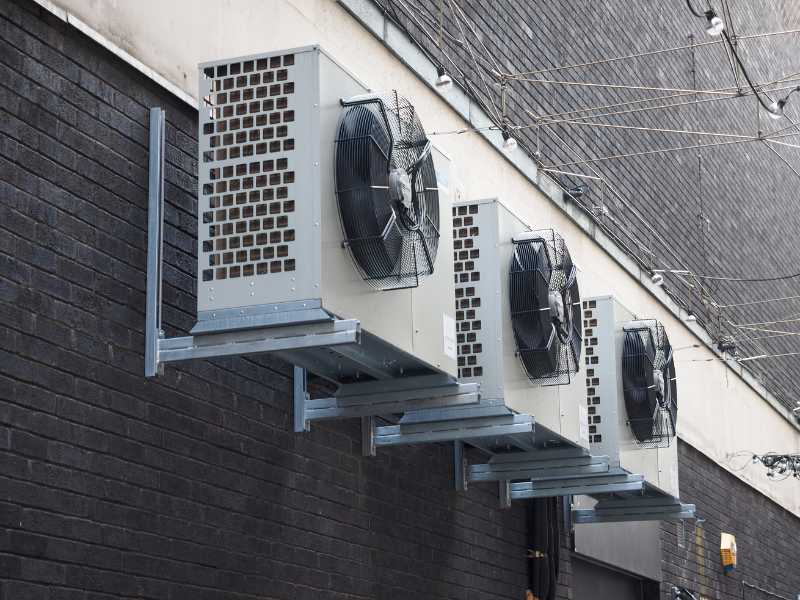
Selecting the right HVAC system requires careful consideration of multiple factors unique to your business and building. Making an informed decision ensures long-term comfort, manageable energy costs, and reliable operation for years to come.
Assessing Your Specific Needs
Begin by thoroughly evaluating your building’s requirements, including total square footage, number of zones needing independent temperature control, occupancy patterns, and unique needs like conference rooms or server areas. Consider the building’s age, construction, ceiling height, window placement, and insulation quality, as these factors significantly impact heating and cooling demands and help determine the most suitable HVAC system for your office.
System Selection Guide by Building Type
For Small Offices (Under 5,000 sq ft): Split systems offer the best combination of easy installation, reliable performance, and cost-effectiveness. They provide straightforward temperature control without the complexity of larger commercial systems.
For Medium Buildings (5,000-20,000 sq ft): Packaged rooftop units deliver excellent performance while saving valuable floor space. They’re ideal for standard office environments with centralized maintenance needs.
For Large Buildings (Over 20,000 sq ft): VRF systems provide superior energy efficiency and zoning capabilities. While the upfront investment is higher, the long-term energy savings and comfort benefits justify the cost for large buildings with varying thermal loads.
Working with HVAC Professionals
Partnering with experienced HVAC professionals ensures you select and install the right system for your office building. Professional assessment includes load calculations to determine exactly how much heating and cooling capacity your space requires—a critical step that prevents the costly mistakes of oversized or undersized systems. Callidus Air specializes in commercial HVAC systems, providing comprehensive assessment, installation, and ongoing maintenance to keep your office comfortable and operating efficiently.
Maintenance Requirements for Commercial Systems
Regular maintenance is non-negotiable for commercial HVAC systems. The maintenance requirements for office systems are more demanding than residential equipment due to longer operating hours and higher usage levels. With proper care, commercial HVAC systems last 15-25 years, making consistent upkeep essential for protecting your investment.
Component Lifespan Expectations
| Component | Average Lifespan | Well-Maintained | Poorly Maintained |
| Complete HVAC System | 15-20 years | 20-25+ years | 12-15 years |
| Air Conditioners | 15-20 years | Up to 25 years | 10-12 years |
| Furnaces | 15-20 years | 20-25 years | 12-15 years |
| Heat Pumps | 15 years | 18-20 years | 10-12 years |
| Boilers | 20-35 years | 30-40 years | 15-20 years |
| Compressors | 8-10 years | 10-12 years | 6-8 years |
Essential Maintenance Schedule
A comprehensive maintenance program includes monthly filter inspections and changes, quarterly system inspections covering electrical connections and refrigerant levels, and annual deep-cleaning of coils and ductwork. These tasks prevent small issues from becoming costly repairs while maintaining energy efficiency throughout the system’s operational life.
Establishing a relationship with a qualified service provider ensures maintenance happens on schedule. Many businesses opt for maintenance contracts that include regular service visits, priority emergency response, and predictable budgeting for upkeep costs.
Recognizing Warning Signs
Watch for indicators that your office HVAC needs professional attention. Unusual noises, inconsistent temperatures across different areas, and rising energy bills all suggest developing problems. Addressing these issues promptly prevents complete system failures that could disrupt business operations. Poor air quality—indicated by stuffy air, odors, or employee complaints about headaches and fatigue—often points to ventilation problems or contaminated filters that require immediate attention.
Improving Air Quality in Office Environments
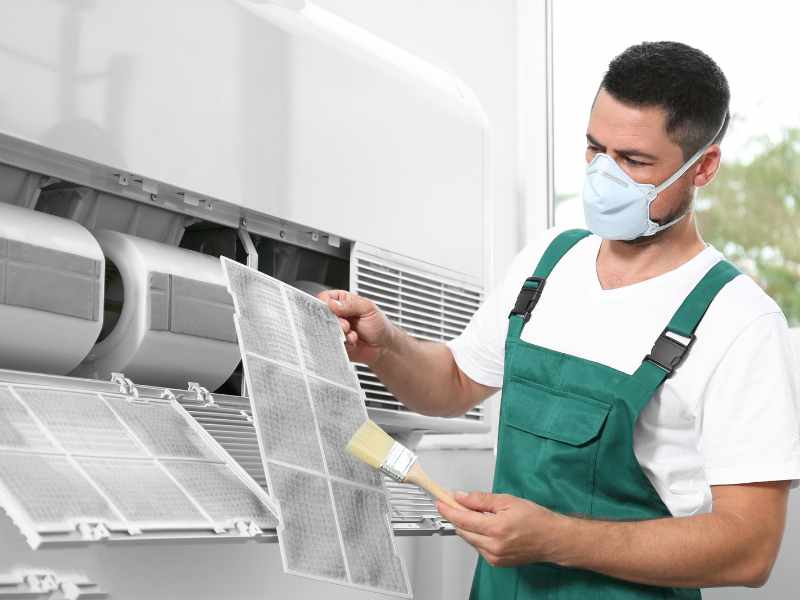
Maintaining proper ventilation and air quality is just as important as temperature control in office buildings. Poor air quality reduces cognitive function, increases sick days, and creates an uncomfortable work environment that impacts productivity and employee satisfaction.
Ventilation Strategies
Adequate ventilation brings fresh air into the building while exhausting stale air, creating a healthy indoor environment. Commercial buildings typically follow standards set by ASHRAE (American Society of Heating, Refrigerating, and Air-Conditioning Engineers) to determine appropriate ventilation rates based on occupancy and building use. Modern systems use demand-controlled ventilation that increases fresh air intake when occupancy is high and reduces it during low-occupancy periods, balancing air quality with energy efficiency.
Key ventilation practices:
- Implement ASHRAE-compliant ventilation rates for your occupancy levels
- Use demand-controlled systems to adjust based on real-time needs
- Increase ventilation during peak occupancy in conference rooms
- Monitor CO2 levels to ensure adequate fresh air circulation
Air Filtration and Purification
High-quality filtration removes particles, allergens, and contaminants from circulating air throughout your office HVAC system. Upgrading to higher-efficiency filters improves air quality but requires ensuring your system’s fans can handle the increased resistance. Some offices benefit from additional air purification technologies like UV lights or electronic air cleaners that capture particles standard filters miss.
The Centers for Disease Control and Prevention recommends enhanced ventilation and filtration as key strategies for maintaining healthy indoor environments, particularly in shared workspaces where multiple employees occupy the same areas throughout the day.
Cost Considerations and Financial Planning
Understanding the financial aspects of office HVAC systems helps you make informed decisions about installations, upgrades, and maintenance investments.
Installation and Operating Costs
New system installations vary significantly based on building size, system type, and complexity. While split systems offer lower upfront costs, VRF systems provide better long-term value through energy savings despite higher initial investments. Operating costs depend primarily on system efficiency, local energy rates, usage patterns, and maintenance quality.
Federal tax incentives available through 2025:
- Up to $2,000 tax credit for qualifying heat pumps
- 30% tax credit for energy-efficient improvements
- Maximum $3,200 annual credit for combined upgrades
Return on Investment Timeline
Energy-efficient systems typically pay for themselves through reduced energy bills within 5-8 years. Buildings upgrading from systems over 15 years old often see immediate savings of 30-40% on heating and cooling costs. Regular maintenance extends system life and maintains peak efficiency, providing better ROI over the equipment’s lifetime.
Conclusion
Investing in the right office HVAC system creates comfortable, productive workplaces while managing operational costs effectively. Whether installing a new system, upgrading existing HVAC equipment, or improving current setup performance, understanding different types of commercial HVAC systems, energy efficiency factors, and maintenance requirements empowers informed decisions benefiting your business long-term. Modern HVAC equipment with proper installation and regular maintenance delivers reliable performance, optimal air quality, and significant energy savings that impact your bottom line.
Ready to optimize your office HVAC system?
Contact us for a professional assessment and discover how modern commercial HVAC solutions transform workspace comfort while reducing energy costs. Our experienced team helps select and install the right system tailored to your building’s specific needs, ensuring maximum efficiency and long-term reliability.
Frequently Asked Questions
This section addresses common questions about office HVAC systems to help you better understand maintenance, sizing, and energy-saving strategies. Whether you’re new to commercial HVAC or looking to optimize your current system, these answers provide valuable insights for managing your building’s climate control effectively.
What is the average lifespan of an office HVAC system?
Commercial HVAC systems typically last 15-25 years with proper maintenance. Neglected systems may fail after just 12-15 years, while well-maintained equipment reaches 20-25+ years. Individual components vary—compressors last 8-10 years, while boilers can operate for 20-35 years with proper care.
How often should office HVAC filters be changed?
Office HVAC filters need monthly inspection and replacement every 1-3 months, depending on usage and air quality. High-occupancy buildings or dusty environments require more frequent changes. Dirty filters restrict airflow, forcing your system to work harder and significantly increasing energy consumption.
What size HVAC system does my office need?
Proper sizing depends on square footage, ceiling height, insulation, windows, occupancy, and equipment loads. Professional load calculations are essential—generic rules often lead to incorrect sizing. Oversized systems waste energy and provide poor humidity control, while undersized units can’t maintain comfort. Always work with qualified HVAC professionals for detailed assessments.
Can I zone different areas of my office for temperature control?
Yes, zoning provides independent temperature control for different areas. VRF systems, multi-split systems, and properly configured packaged units all support zoning. This improves comfort while reducing energy waste in unoccupied areas—particularly valuable for offices with conference rooms, private offices, and open workspaces.
How can I reduce my office HVAC energy costs?
Key strategies include regular maintenance, programmable thermostats, proper zoning, and energy-efficient equipment upgrades. Simple steps like adjusting temperatures during off-hours and sealing air leaks make a significant impact. Energy-efficient systems save an average of $500 annually, while sealing duct leaks improves efficiency by up to 20%. Consider a professional energy audit to identify specific savings opportunities.

